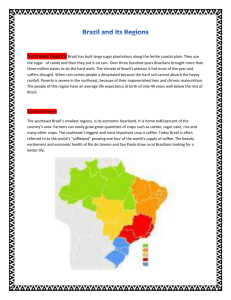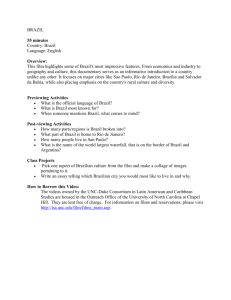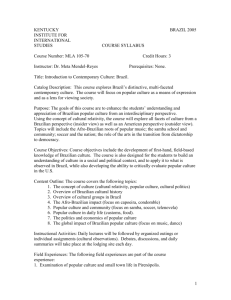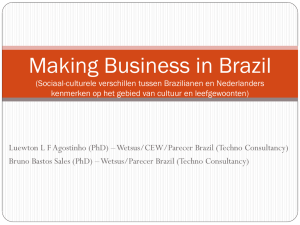Brazil Culture Gram here
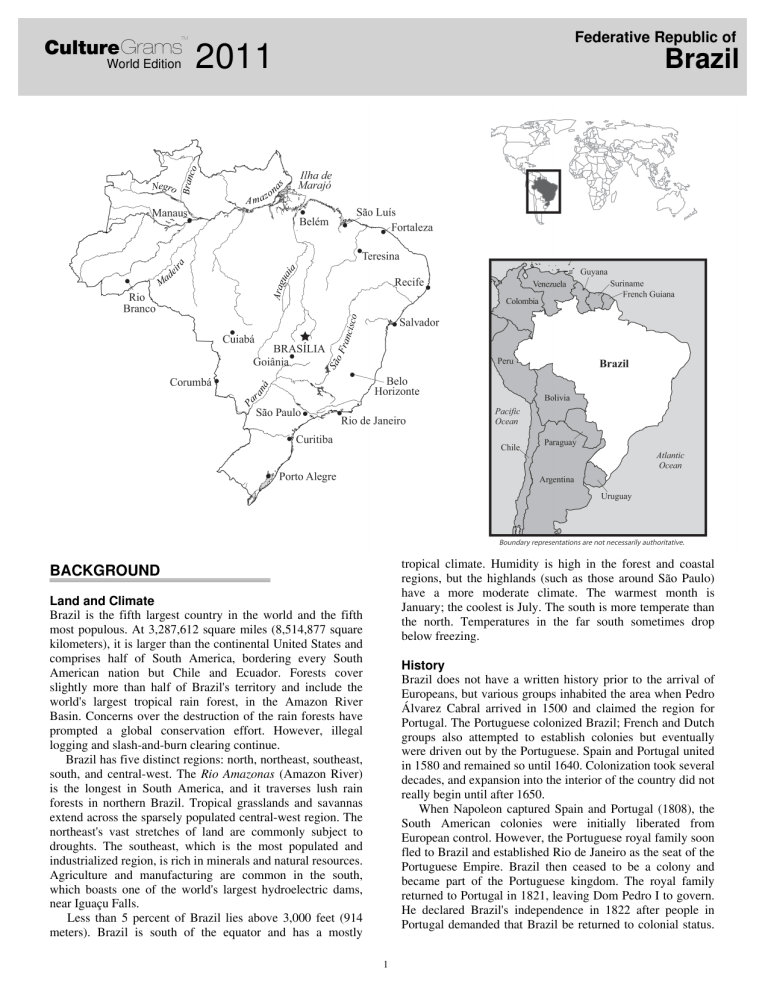
Culture Grams
TM
World Edition
2011
Federative Republic of
Brazil
BACKGROUND
Land and Climate
Brazil is the fifth largest country in the world and the fifth most populous. At 3,287,612 square miles (8,514,877 square kilometers), it is larger than the continental United States and comprises half of South America, bordering every South
American nation but Chile and Ecuador. Forests cover slightly more than half of Brazil's territory and include the world's largest tropical rain forest, in the Amazon River
Basin. Concerns over the destruction of the rain forests have prompted a global conservation effort. However, illegal logging and slash-and-burn clearing continue.
Brazil has five distinct regions: north, northeast, southeast, south, and central-west. The Rio Amazonas (Amazon River) is the longest in South America, and it traverses lush rain forests in northern Brazil. Tropical grasslands and savannas extend across the sparsely populated central-west region. The northeast's vast stretches of land are commonly subject to droughts. The southeast, which is the most populated and industrialized region, is rich in minerals and natural resources.
Agriculture and manufacturing are common in the south, which boasts one of the world's largest hydroelectric dams, near Iguaçu Falls.
Less than 5 percent of Brazil lies above 3,000 feet (914 meters). Brazil is south of the equator and has a mostly
1 tropical climate. Humidity is high in the forest and coastal regions, but the highlands (such as those around São Paulo) have a more moderate climate. The warmest month is
January; the coolest is July. The south is more temperate than the north. Temperatures in the far south sometimes drop below freezing.
History
Brazil does not have a written history prior to the arrival of
Europeans, but various groups inhabited the area when Pedro
Álvarez Cabral arrived in 1500 and claimed the region for
Portugal. The Portuguese colonized Brazil; French and Dutch groups also attempted to establish colonies but eventually were driven out by the Portuguese. Spain and Portugal united in 1580 and remained so until 1640. Colonization took several decades, and expansion into the interior of the country did not really begin until after 1650.
When Napoleon captured Spain and Portugal (1808), the
South American colonies were initially liberated from
European control. However, the Portuguese royal family soon fled to Brazil and established Rio de Janeiro as the seat of the
Portuguese Empire. Brazil then ceased to be a colony and became part of the Portuguese kingdom. The royal family returned to Portugal in 1821, leaving Dom Pedro I to govern.
He declared Brazil's independence in 1822 after people in
Portugal demanded that Brazil be returned to colonial status.
Culture Grams TM
His son, Dom Pedro II, was deposed in an 1889 military coup.
The military would eventually seize control three more times, although with relatively little violence. With military support, the dictator Getúlio Vargas ruled from 1930 to 1945, followed by elected presidents. A 1964 coup gave the military control until a return to civilian rule in 1985. A new constitution was ratified in 1988.
Elections in 1989 brought Fernando Collor de Mello, a conservative, to office. Collor was the first president to be directly elected in 29 years. His economic austerity campaign and corrupt activities crippled the economy. In a historic test of democracy, Brazil succeeded in removing the president from office by legal, constitutional means. Before impeachment proceedings could be carried out, however,
Collor resigned in December 1992.
Vice President Itamar Franco assumed the presidency until elections in October 1994. Franco's finance minister,
Fernando Cardoso, introduced an anti-inflation plan so successful that the economy began to boom in 1994. Cardoso, who had spent years in exile after the 1964 military coup, eventually upset the front-running presidential candidate and later became the first Brazilian president to be elected to a second consecutive term.
In 2002, the first left-wing president in 40 years came to power and was reelected in 2006. Luiz Inacio Lula da Silva promised to reform the economy and to eradicate hunger.
Lula completed his final term in 2010 and was succeeded by
Dilma Rousseff, Brazil's first female president. While much progress was made under Lula, the nation still faces stark inequality of wealth, high levels of crime, and a weak economy. In 2008, the government began an aggressive campaign to take control of the city's dangerous slums from the hands of powerful drug gangs. In November 2010, after days of intense fighting, the government claimed victory.
THE PEOPLE
Population
The population of Brazil is approximately 201.1 million and is growing annually at a rate of about 1.2 percent. More than
85 percent of the people live in cities. São Paulo and Rio de
Janeiro are the two largest cities. Brasília, the new capital, was completed in 1960 after having almost every detail of the city planned by the government; its population now numbers more than two million.
About 27 percent of the population is younger than age 15.
Brazilians of European (mostly Portuguese) descent comprise
54 percent of the population, while 39 percent is of mixed heritage and 6 percent is of African descent. The indigenous population today numbers only a few hundred thousand.
Many of these peoples inhabit the Amazon region, and a few groups have never been contacted by modern society. Many people of mixed heritage have some indigenous blood through intermarriage. Groups of German, Italian, Lebanese, and Japanese immigrants who settled in the south maintain ethnic communities. In fact, Brazil is home to the largest cohesive community of Japanese outside of Japan. The black population descended from African slaves brought to Brazil
Brazil before the 1880s; they live mostly in northeastern states like
Bahia.
Language
Portuguese is Brazil's official language. It differs slightly in pronunciation from the Portuguese spoken in Portugal.
English is popular as a second language. Spanish is also becoming more popular in some circles as Brazil establishes stronger trade ties with its neighbors. (Although Portuguese speakers generally understand Spanish, some Brazilians are offended when deliberately spoken to in Spanish.) In southern cities, some descendants of European immigrants also speak
German or Italian. Indigenous peoples may speak any one of more than a hundred local languages.
Religion
Brazil traditionally has been a strong Roman Catholic country. At one time, nearly 95 percent of the population claimed membership in the Catholic Church. However, membership has dropped to around 75 percent, and other
Christian churches are growing rapidly. Since the founding of the republic in 1889, there has been a separation of church and state, and religious freedom has been guaranteed.
Although Brazilians consider themselves quite religious, most attend church only on special occasions. Some in the northeast and in urban areas countrywide practice
Afro-Brazilian religions that combine various indigenous
African beliefs with Catholicism. These Afro-Brazilian religions, such as Candomblé, Macumba, and Xangô, share many similarities.
General Attitudes
Brazilians are warm, fun-loving, and free-spirited. They are also outgoing and enjoy being around others. At the same time, they are hard working. Brazilians are proud of their country's natural resources and diverse culture. Most people of mixed ancestry identify with and value all parts of their heritage. One point of pride is the “Brazilian way”—their ability to find creative ways around seemingly insurmountable problems. Brazilians often are opinionated and will argue for their convictions with vigor. In spite of economic difficulties, most Brazilians are hopeful about their country's future.
Social status commonly is measured by one's power to acquire possessions. People tend to view time more as a sequence of events than as a matter of hours and minutes.
Therefore, people in most regions (except São Paulo) appear to have an extremely casual attitude about time. Brazilians in the north and northeast regions and small inland towns are traditionally more conservative. Folklore is stronger in these areas; traditional religious and military celebrations are also more common.
Personal Appearance
In general, Brazilians are fashionable and like to dress according to the latest styles. People in urban areas like to wear brand-name clothing. People in the warmest and most humid regions dress more casually. People in these areas generally wear light or brightly colored clothing. In São Paulo
2
Culture Grams TM and parts of the southern region, people often dress in black, white, and other neutral colors. Stylish suits or skirts with jackets are common business attire. Both men and women pay careful attention to their appearance. Shoes are well kept and polished. Manicures and pedicures are popular. People like to dress up for special occasions and parties. In rural regions, more traditional clothing is common, especially among the native peoples.
CUSTOMS AND COURTESIES
Greetings
In formal situations, Brazilians greet each other with a handshake. A common greeting among friends, except from one male to another, is to embrace and kiss on alternating cheeks or touch cheeks and “kiss the air.” In some regions, three kisses are exchanged. Common verbal greetings include
Olá. Tudo bem?
(Hello. Is everything fine?) and Como vai?
(How are you?). Young friends greet each other with a simple
Oi (Hi). When one joins or leaves a small group, it is polite to shake hands with everyone. Common parting terms include
Tcháu (Good-bye) and Até logo (See you soon). Superiors and authorities may be addressed formally with the titles
Senhor (Mr.) or Senhora (Mrs.), followed by their surnames.
In less formal situations, first names are commonly used, sometimes preceded by Seu (for men) or Dona (for women).
Gestures
Brazilians often use gestures to communicate and express feelings. Gestures often accompany greetings. One beckons by closing the fingers of the hand into the palm facing up.
Pulling down the lower eyelid with an index finger signifies disbelief or caution. One may tap the fingers horizontally under the chin to indicate that another person does not know what he or she is talking about or is exaggerating. The “okay” sign used in the United States, with the thumb and index finger forming a circle, is an offensive gesture.
Brazilians tend to stand close and touch each other often during conversation. Eye contact is important. Passing between conversing individuals is rude. Men tend to stare at and make comments about women passing by. This is generally ignored by the women.
Visiting
Brazilians enjoy visiting. The tropical climate allows for much time outdoors, including chatting outside late into the evening. If a meal or snack is in progress, it is considered impolite not to ask visitors to join in eating. Most people will politely decline the invitation Está servido?
(Will you join me?) with Bom apetite (Enjoy). Hosts generally also offer coffee or other refreshment toward the end of a visit. In rural areas, not accepting refreshments may be considered rude. If invited to dinner, one might take candy, wine, or a small gift to the hosts. Invited guests commonly arrive up to a half hour late, except perhaps in São Paulo. Guests are generally expected to stay at least two hours. While Brazilians enjoy conversation, they avoid controversial subjects (like politics and religion) at social gatherings. Asking personal questions
Brazil about one's age, salary, etc., is considered inappropriate.
Eating
Brazilians value mealtime with family and friends. The average Brazilian eats three meals a day. Breakfast ( café da manha ) is usually eaten between 6 and 8 a.m., lunch ( almoco ) is taken between noon and 2 p.m., and dinner ( jantar ) is eaten between 6 and 8 p.m. Extended family members often gather together for lunch on Sundays. Brazilians eat in the continental style, with the knife in the right hand and the fork in the left. One wipes the mouth frequently throughout a meal before drinking. After-meal conversation often takes place over a cup of strong cafezinho (black coffee). In restaurants, diners call the server by holding up the index finger or by softly saying Garçom (Waiter). While the bill usually includes the tip, one may leave extra change. If the tip is not included, leaving 10 to 15 percent is customary.
LIFESTYLE
Family
Brazilian families are tightly knit. The extended family forms a safety net that people can count on in times of need.
Families gather for a variety of events and holidays throughout the year. Most gatherings are less about the stated purpose and more about spending time together.
Family size varies depending on many factors, including the economic status of the family, geographic location, and level of education. Poorer families traditionally are larger, often consisting of as many as five to eight children, while families in the middle and upper classes tend to be smaller, averaging one to two children. The overall trend, however, is for families from all classes to be smaller than they once were. Children in poorer families often must work to help support their families and may not be able to complete their schooling. Government aid programs to provide education, food, housing, and health care for the poorest of these families have provided some short-term help, but extreme poverty remains an ongoing problem for many Brazilians.
Brazilian society is generally patriarchal, with the man of the household supporting the family financially and making the decisions, while the woman is responsible for the care of the home and the family. This pattern remains especially strong among the rural poor but is present among other classes as well. However, a combination of economic conditions and changing attitudes toward gender roles has resulted in an increasing number of women entering the work force. More women are seeking education, and there are increasing numbers of private businesses or individuals who provide childcare for those who have children. Women have taken on leadership roles in business and politics and are gaining respect and experience outside the home. Among most rural families, however, men continue to participate minimally in the upbringing of the children and the care of the household. In urban areas, gender roles are changing more dramatically, and men and women are more likely to share decision making and household tasks. Middle- and upper-income families often hire domestic help.
3
Culture Grams TM
Children rarely leave home before they marry. Unmarried men may move out to seek better economic opportunities elsewhere, but they usually live at home until around age 30.
Most young couples move into their own home after they marry. Due to the weak economy, some couples may live with one set of parents while they save up enough money to buy or rent their own home. The elderly who cannot care for themselves often live with their children, which is considered preferable to living in a nursing home.
Housing
In Brazilian cities, most people live in houses or apartments built in a style similar to U.S. townhouses. Homes typically have a half-bathroom, a living room, and a kitchen on the ground floor, then two bedrooms and a full bathroom upstairs.
Homes are usually constructed of brick and concrete with tiled roofs. Upper-class homes may use wood, marble, or granite. Interior decorations vary according to a family's income. However, regardless of income, people enjoy decorating and redecorating their homes every few years.
Floors are generally tile, wood, marble, or cement. Carpeting is fairly uncommon. Plumbing works well most of the time, but to deal with water shortages, many Brazilian families buy their own water tanks and place them on the roof. Those with backyards often construct brick barbecues for use at social gatherings.
In high-crime urban areas, there is an emphasis on home security. Tall walls, which were first introduced by
Portuguese colonists, and a security gate are often built in the front of a house. Many homeowners go further, keeping guard dogs, installing alarm systems, and even placing broken glass on top of the walls.
Because of the uneven distribution of land in Brazil, many of the country's landless live on the outskirts of urban centers, in favelas (shantytowns), where crime is rampant. The poor commonly lack the basic necessities of life, including food, sanitation, and shelter. The Brazilian term jetinho describes the Brazilian talent of making do in difficult circumstances.
Brazilians find a way to use whatever materials they have to repair and make improvements to their homes. A little ingenuity can save money that would otherwise have to be paid to a professional repair person.
Dating and Marriage
Attitudes about dating have changed significantly in recent years, and dating customs vary depending on socioeconomic class, location, and personal values. In less traditional families, dating begins as early as 12 or 13. Other families encourage group dating, which often begins around age 14; couples gradually emerge from the group. Traditional families expect a young man to ask the girl's father for permission to date her. Adolescents meet each other at dance clubs, in their neighborhoods, or at school. Most couples date for two or three years before getting engaged or married. Traditionally,
Brazilians married young. However, today, many couples wait until they are older (perhaps in their 30s) to marry.
Couples often prefer to remain unmarried until they have a chance to earn a degree, find a job, and in some cases, afford
Brazil a house. Some couples prefer to live together and raise a family, avoiding marriage altogether.
Before a woman gets married, her close friends, family, and relatives throw her a bridal shower with presents and activities related to the wedding. Weddings usually include two ceremonies: one civil and one religious. The civil ceremony must be complete before a church wedding may be held. Couples go to a government office to sign a registry in front of a judge to receive a marriage certificate. The couple then exchanges rings. For the religious ceremony, the couple brings their marriage certificate to the church before the ceremony. The church ceremony is expected to start late while the bride finishes getting ready, though usually not by more than 15 minutes. The bride's godfather and the groom stand at the front of the church, near the altar. The bride enters from the back of the chapel, escorted by her father or another close relative. When she reaches the altar, the groom takes her hand, and the two stand together to be married by the priest.
After the ceremony, a festive party is held, usually at a rented hall or the home of the bride or groom's parents.
Wedding parties are lavish and elegant, with much food, drink, and music. Partway through the party, the couple leaves for their honeymoon. The guests see them off and then continue the party, which often lasts late into the night.
In the past, there was considerable stigma associated with divorce because of societal taboos and religious restrictions.
Couples had to wait for several years before they could remarry after a divorce. Today, those restrictions have been relaxed, and divorce is much more widely accepted.
Life Cycle
Rituals marking major life events invariably provide
Brazilians with an opportunity to dress up, dance, sing, and spend time with their family and friends. Pregnancy is eagerly celebrated in Brazilian culture, and there is no attempt to hide a pregnant woman's growing stomach. Babies are often given names identical to or derived from the names of their parents.
A child may also be named after a friend of the parents or a relative. Friends and relatives typically throw a party with baby gifts for the expecting mother a month or so before the baby is born. After the baby is born, it is traditional to send flowers or other gifts to the mother, and visits from family, extended relatives, and friends are expected. The first birthday is one of the most important and is celebrated with a large party.
A young woman is traditionally introduced to society at a ball held on her fifteenth birthday, or quinceañera . This event marks the girl's transition from childhood to young womanhood. Boys wear a suit or tuxedo, and girls wear long formal dresses. Dinner is usually served and is followed by a dance, often with a hired band for accompaniment. She dances the first dance with her father and then with her boyfriend, if she has one, or any of the young men present.
Once the girl has danced, other couples may join the dance themselves. Due to the high costs of such a ball, this tradition is practiced only among the wealthy.
Young Brazilians are considered adults when they turn 18 and graduate from secondary school. At this age, it is
4
Culture Grams TM mandatory that they vote in elections, and they are allowed to obtain a driver's license. It is obligatory for men to enter the military at age 19, where they must serve for a minimum of
12 months.
When a person dies, the nature of the funeral arrangements depends in large part on what the family can afford. In most cases, burial occurs within 24 hours of death. Cremation is rare and very expensive. A funeral home or members of a church will clean and dress the body. Before burial, the body typically stays at the funeral home to be viewed by family members and friends. Funerals typically include a religious service, readings from scripture, singing of hymns, and prayer. Attendance of funerals is an important sign of respect for both the deceased and the family. A special mass is performed in the case of Catholic funerals. Family members are usually buried in the same cemetery, often for multiple generations. At first, headstones tend to be quite basic, and little may be done to the burial plot. However, both may be improved in time, when families have been able to save money for the purpose.
Diet
Much of Brazil's food reflects its cultural diversity, and each region has its own unique offerings. Staple foods in the
Brazilian diet include meat, bread, rice, beans, cheese, and eggs. Breakfast usually consists of café com leite (coffee with milk), fruit, and bread with butter. Lunch is the main meal and often includes beans, rice, meat, salad, potatoes, bread, and fruit. Dinner is lighter and may include a bowl of soup with bread, followed by coffee or milk with a piece of cake.
Pastries are typical snacks. Favorite foods vary by region. In
Bahia and other states, foods may be spiced with dendê (palm oil). In Rio de Janeiro, the favorite is feijoada (black beans with beef, pork, sausage, and sometimes a pig's ears, feet, and tail), which was created by African slaves using ingredients that their Portuguese masters would not eat.
Churrasco , which originated in the south, is a barbecue with a variety of meats.
Bife à cavalo com fritas (meat with egg and french fries) is popular in many areas. Common drinks include lemonade, milk, fruit juices and shakes, soft drinks, coffee, and an herbal tea called mate (MAH-tay), which is enjoyed in southern states.
Recreation
The national sport and passion is futebol (soccer). Businesses and schools may even close during the World Cup. People of all socioeconomic classes enjoy watching and playing soccer and, when they aren't able to attend the games in person, often meet at each other's homes or at clubs to watch, usually dressing in the uniform of their favorite team. When a playing field is not available, soccer games take place on neighborhood streets. Basketball and volleyball are also popular sports, both to play and to watch. People enjoy boating, fishing, swimming, and visiting the country's many beaches. Brazilians are avid fans of auto racing.
During leisure hours, people commonly visit friends or watch television, particularly telenovelas (nighttime soap operas). Traditional dances and festivals are popular and vary by region. Brazilians enjoy celebrating any occasion, and
Brazil get-togethers often include singing and Samba dancing.
Weekend and holiday barbecues are common. People often get together to simply converse with friends and family at a churrasco (barbecue).
Many people enjoy going to local parks to jog, walk, or bike. Athletic clubs are also popular, especially those with swimming pools, which are always busy on hot summer days.
Children spend much of their time outside, playing various games and sports. Older people enjoy playing an Italian game called bocce (similar to bowling) and cards.
People of all ages enjoy dancing. Young people enjoy going to dance clubs on the weekends. Dancing is often a part of many informal gatherings, where people dance, talk, eat, drink, and socialize at someone's home.
Both rich and poor enjoy listening to live music, and international musicians often visit Brazil. Larger cities have many concerts, plays, and museums. Brazilians also love going to the movies. In urban areas, people enjoy walking in the malls, which are often chosen as the place to meet friends and hang out, especially among the younger generation.
Nearly all Brazilians go on vacation each year. Families often travel together to the beach or to rural areas surrounded by forests, lakes, and streams. People enjoy visiting different parts of their country, as Brazil's vast territory includes a variety of landscapes and cultures. Many families have vacation homes, have a friend or relative with a vacation home they can use, or arrange to rent one. People from rural areas often travel to cities and stay with friends or family there.
The Arts
The arts in Brazil have a rich and vast tradition that extends back to European (Portuguese, Italian, German, and Dutch),
African, and indigenous roots. Music, sculpture, architecture, and painting were all brought to Brazil during the years of colonization (from the 16th century to the mid-19th century), much of it by Jesuits, who came to Brazil as Catholic missionaries. All cultures within Brazil have influenced the country's music, dance, and festivals. For example, Samba is the most popular music and dance style, and it uses African rhythms blended with European-style singing. Other popular
Brazilian forms, such as Pagode (similar to Samba), Axé
(“soul”) music, and Bossa Nova (roughly “new wave,” or
“new thing”) all originated from this style. Bossa Nova combines Brazilian popular music with jazz, and is often known internationally as “Brazilian Jazz.” Capoeira combines dancing with martial arts in a style that dates back to the period of slavery and includes dancers performing moves that mimic a warrior in battle.
Pottery, usually made by hand and painted with religious or domestic scenes, is popular throughout Brazil. In the north and northeast, artisans produce beautiful handcrafted hammocks, crocheted and knitted clothing, and decorative ceramic items depicting the local culture's daily activities.
Architecture is heavily influenced by the Portuguese. Brazil is home to such important architects as Antônio Francisco
Lisboa, from the 18th century—a designer and builder of cathedrals and statues—and modern architect Oscar
Neimeyer, whose designs can be seen in Brasília, the modern
5
Culture Grams TM capital.
Brazilian literature has been influenced by European movements, and writers often combine traditional and modern styles in their work. Many of the early literary contributions came from Jesuit priests, who wrote many poems and pieces of music. One of the most famous poems in the Brazilian tradition is “O Guarani,” written by José de Alencar. Another important writer, Machado de Assis, wrote a great number of books during the 19th century that are still read today.
Modern Brazilian writers, such as Fernando Veríssimo and
Paul Coelho have wide international appeal.
Folklore is popular in all regions of Brazil. Brazilian folklore features various strange mythical characters, such as
O Boto, a pink dolphin; Boitatá, a snake covered with flames;
Cobra Grande, a huge snake living in the Amazon that frightens people by changing shape; Bicho Papão, a monster who eats children; and many others.
Holidays
Most Brazilian holidays are primarily historic or religious
(Catholic) events.
Carnaval is a five-day festival leading up to Ash Wednesday; it is the most famous holiday in Brazil.
The largest parades take place in Rio de Janeiro and São
Paulo, but smaller cities and towns hold elaborate celebrations as well. Teams called “Samba schools” prepare dances, floats, and elaborate costumes and compete with each other for prizes and recognition. Activities include music and bloco (group) dancing, parties, and drinking. Some people spend months preparing costumes and saving their money for
Carnaval activities. It is a popular time to go to the beach or to dance clubs.
After Carnaval comes Ash Wednesday, when many
Brazilians observe the Catholic tradition of avoiding meat and eating only fish. This period is followed by 40 days of Lent in preparation for Easter. During Lent, those who wish to do so participate in fasting and giving up something as a sacrifice
(such as a bad habit) as an indication of their Christian faith.
Easter is celebrated with both religious and secular traditions. Children enjoy exchanging chocolate eggs, and a special supper is often prepared. Christian believers take part in processions in which crosses are carried, sometimes with effigies of Jesus attached. Catholic churches hold a special
Easter Mass, and other Christian churches often hold an
Easter service as well.
Brazil's independence is celebrated on 7 September.
Movies that tell the story of independence are shown on television, and schoolchildren go on field trips to museums prior to the holiday to learn more about the history of
Brazilian independence. Parades are held throughout the country, and communities put together patriotic displays.
Brazilians of African descent commemorate 20 November in honor of the death of Zumbi, an important African resistance leader from the 17th century. He died while leading a large group of slaves in an attack against a plantation.
Workshops and classes are held on this day to teach about racial discrimination.
On Christmas Eve, people eat a big meal (which usually includes turkey or ham) and exchange gifts, some of which are brought by Papai Noel (Father Noel), a figure similar to
Brazil the Western Santa Claus and Father Christmas. He is said to either enter through the chimney or leave his presents on the window sill. New Year's Eve is a time for large parties. In some areas, Candomblé believers dress in white and blue to honor the sea goddess Iemanjá and gain energy for the coming year. People place flowers and candles on beaches as part of the celebration.
Other holidays include Tiradentes Day (21 Apr.), which celebrates the death of Joaquim José da Silva Xavier (known as Tiradentes), a dentist and nationalist who died in the struggle for independence. The Festas Juninas (June
Festivals) coincide with the feasts of St. Anthony (13 June),
St. John (24 June), and St. Peter (29 June) and are celebrated with local fair-type activities. Other holidays include Labor
Day (1 May), Memorial Day (2 Nov.), and Republic Day (15
Nov.).
SOCIETY
Government
Brazil is a federative republic consisting of 26 states and one federal district (Brasília). Technically, each state is autonomous with a legislative body and elected governor, but the federal government reserves all rights not delegated to the state. The president (currently Dilma Rousseff) is head of state and government. A 1997 constitutional amendment allows presidents, governors, and mayors to run for two consecutive terms. The National Congress has an 81-seat
Federal Senate and a 513-seat Chamber of Deputies. Voting is universal and compulsory for ages 19 to 70. It is optional for
16- to 18-year-olds and those older than 70. Active members of the military do not vote.
Economy
Brazil has the largest economy in South America and one of the largest economies in the world. However, income distribution is highly unequal, and poverty affects roughly 25 percent of the total population. Inequitable land distribution is a contributing factor: nearly half of all private lands are owned by only 1 percent of the people. Hyperinflation and low growth marked the 1980s and early 1990s. The introduction of the new currency, the real (BRL), in 1994, helped to dramatically cut inflation. Despite an economic crisis caused by weakened investor confidence and a subsequent currency devaluation, the Brazilian economy has remained relatively stable, spurred on by government spending cuts, tax increases, and other emergency measures.
The 2008 global economic crises threw Brazil's economy into recession, but it stabilized and began growing again in 2009.
Unemployment is moderate in some areas but high in larger cities such as São Paulo.
Brazil is largely self-sufficient in food and consumer goods.
Agriculture employs about 20 percent of the population.
Brazil is one of the world's largest producers of coffee, oranges, and bananas. Much of Brazil's sugarcane is used to produce ethyl alcohol, a fuel used in approximately one-third of Brazilian cars. The industrial sector exports automobiles and parts, textiles, minerals, and metals; other industries
6
Culture Grams TM include cement and chemicals. Despite large reserves, Brazil lacks the capacity to refine the oil it mines on its own soil.
Consequently, the country must import a quarter of the 2.46
million barrels of oil it uses daily. Much of Brazil's natural gas is also imported. Brazil is a member of Mercosur, a regional free-trade pact that includes Argentina, Paraguay, and Uruguay.
Transportation and Communications
Domestic air travel is well developed between hundreds of local airports. Travel by intercity bus is more common, although buses tend to be crowded. São Paulo and Rio de
Janeiro have rapid transit systems. City buses do not stop automatically; people must hail them with the wave of a hand.
Taxis are readily available in large cities. Those with red license plates have fixed meter rates.
Brazil's media are highly developed and include one of the world's largest television networks. Televisions are found in even the poorest areas. The country also enjoys a large film and music industry. Urban telephone service is good. Pay phones are operated by tokens or phone cards, not coins.
Cellular phones are ubiquitous. Most people have access to the internet.
Education
Education is highly valued in Brazilian society and is seen as the key to overcoming the country's economic difficulties.
However, the economic situation of many families prevents some children from receiving a quality education.
Education is compulsory for nine years (ages 6 to 14).
Primary school lasts five years. It is followed by four years of middle school. After completing the required years of schooling, students may choose to attend three additional years of secondary school. Attendance is not always strictly enforced, particularly among the older students, many of whom leave school early to help their parents support the family. Children typically begin school at the age of six, although some attend preschool before then. In elementary school, students learn reading, writing, math, Portuguese, physical education, basic world history, and science. In late middle school and high school, students take physics, biology, chemistry, calculus, geography, history, sociology, art, psychology, and foreign languages (particularly, English,
Spanish, French, and German). Labs, libraries, and the latest technology are available to students in many schools, but uniforms and most school supplies must be paid for by students and their families. Students who cannot afford these costs sometimes receive donated supplies so they can go to school. About 95 percent of children attend primary school, with slightly more boys attending than girls. In secondary school, girls outnumber boys, with 85 percent of girls attending compared to 78 percent of boys.
Private schools are available and typically offer strong educational programs but at a high cost, which is not affordable for most Brazilian families. Many of these schools are run by the Catholic Church and include religious instruction as part of the curriculum.
Entrance to Brazil's top universities is difficult and is preceded by a special college-preparation course and entrance
Brazil exam. Much of secondary education is aimed at helping students do well on this exam, and many students hire tutors or take courses to help them study.
About half of secondary school graduates go on to trade schools, where they train as technicians, as mechanics, and for various other professions. There are hundreds of higher education institutions. A national adult literacy program has raised the literacy rate substantially.
Health
Brazil's healthcare system provides universal coverage.
However, rural areas rarely have adequate facilities. Excellent private care is available in large cities to those who can afford it. Some water is not potable. Sanitation in some areas is insufficient. Yellow fever and malaria are found in some areas. A grassroots effort is dispatching mobile healthcare workers to rural areas to fight infant mortality through education and basic care. AIDS is a growing problem.
AT A GLANCE
Contact Information
Embassy of Brazil, 3006 Massachusetts Avenue NW,
Washington, DC 20008; phone (202) 238-2805; web site www.brasilemb.org. Brazilian Tourist Board, 6 West 44th
Street, Suite 1401, New York, NY 10036; phone (646)
378-2126; web site www.braziltour.com.
POPULATION & AREA
Population
Area, sq. mi.
Area, sq. km.
201,103,330 (rank=5)
3,287,612 (rank=6)
8,514,877
DEVELOPMENT DATA
Human Dev. Index* rank
Gender inequality rank
Real GDP per capita
Adult literacy rate
Infant mortality rate
Life expectancy
73 of 182 countries
80 of 155 countries
$10,100
88% (male); 89% (female)
22 per 1,000 births
69 (male); 76 (female)
* UN Development Programme, Human Development Report 2010 (New York: Palgrave
Macmillan, 2010).
Culture Grams
ProQuest
789 East Eisenhower Parkway
Ann Arbor, Michigan 48106 USA
Toll Free: 1.800.521.3042
Fax: 1.800.864.0019
www.culturegrams.com
TM
© 2011 ProQuest LLC and Brigham Young University. It is against the law to copy, reprint, store, or transmit any part of this publication in any form by any means without strict written permission from ProQuest.
7

